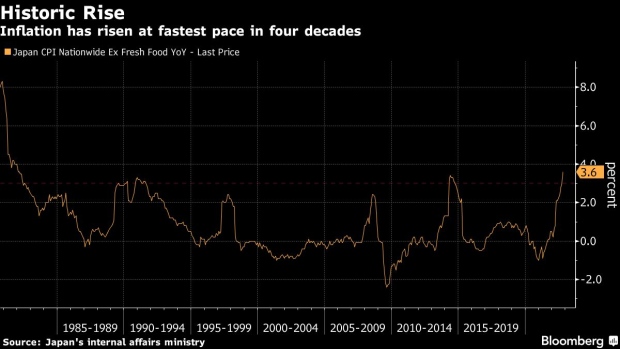Nov 17, 2022
Japan Inflation Hits Four-Decade High in Test of BOJ Resolve
, Bloomberg News

(Bloomberg) -- Japan’s inflation hit its fastest clip in 40 years in October, an outcome that further stretches the credibility of the central bank’s view that continued stimulus is needed to secure stable price growth.
Consumer prices excluding fresh food climbed 3.6% in October from a year ago, the internal affairs ministry said Friday.
The reading outpaced a 3.5% forecast by analysts and marks the fastest price growth since 1982. Core inflation has now exceeded the Bank of Japan’s 2% price target for seven straight months, with the yen’s historic fall amplifying the trend.
Following the release, Governor Haruhiko Kuroda reiterated his view that the central bank’s ultra-low interest rates remain appropriate, though he acknowledged that the latest gains were significant and inflation could accelerate further.
While economists largely agree with the BOJ that inflation will cool in Japan next year, partly as a result of government subsidies, some analysts see the central bank underestimating the underlying strength of prices.
“It’s getting harder for the BOJ to keep saying that the current cost-push inflation is temporary,” said Mari Iwashita, chief market economist at Daiwa Securities Co. “If the yen remains weak, more companies will try to pass on costs to consumers.”
Kuroda’s BOJ remains the outlier among major central banks. While his peers have long since given up the view that hot prices are merely transitory, and have aggressively raised borrowing costs, Kuroda has stuck resolutely with rock-bottom interest rates.
That stance has helped drive the yen to 32-year lows against the dollar, prompting repeated government intervention in currency markets.
Kuroda has consistently maintained that the current inflation is unsustainable and driven by import costs and the weaker currency, as he looks to keep policy on hold during the final months of his leadership.
“I believe price growth will fall below 2% next fiscal year onward,” Kuroda said in parliament Friday.
The latest data show that price rises are continuing to spread beyond energy costs.
Gains in processed food costs now outweigh the impact of elevated power and fuel prices, the report showed. Excluding fresh food and energy, price growth has reached 2.5%, an indication that the strength of the inflation trend is firmly beyond 2%.
In October, companies raised prices on about 6,700 food items, ranging from mayonnaise to beverages, according to a Teikoku Databank survey. Although the trend appears to have peaked last month, another 833 food items, including dairy products, are expected to go up in November.
To ease the hit of higher prices on consumption, Prime Minister Fumio Kishida last month ordered an economic stimulus package that includes aid to reduce energy costs and cash handouts for childcare. His cabinet has approved an extra budget of 29.1 trillion yen ($208 billion) to partly fund these measures.
What Bloomberg Economics Says...
“The government is putting no pressure on the BOJ to pivot. It prefers to keep interest rates ultra-low to finance its debt, including the new borrowing required by its latest stimulus package.”
-- Yuki Masujima, economist
For the full report, click here
Some analysts see the impact of the subsidies lowering the inflation rate by more than one percentage point next year, a factor that will mask the underlying strength of price growth.
SMBC Nikko Securities economists expect the key inflation gauge to slow to around 2.5% early next year due to the measures. As the support is phased out in stages, price growth will probably start to accelerate again to around 3% in 2024, economists led by Koya Miyamae wrote in a report.
Kuroda, whose term finishes in April, has singled out wage growth as the key factor needed to create an environment of lasting growth in prices and the economy. The governor repeated his view that 3% wage growth is needed for 2% inflation to last.
“It’s not desirable to tighten policy and raise rates now, as that would delay the economic recovery and lessen firms’ ability to raise wages,” Kuroda said.
The governor’s caution also likely draws on previous moves to raise rates prematurely in the BOJ’s past, and the sharp fall in consumer spending seen after a tax hike in 2014 pushed inflation over 3%.
“When companies passed their costs onto consumers just before the global financial crisis, it didn’t last,” said Seisaku Kameda, a former BOJ chief economist and current executive economist at Sompo Institute Plus. “I still can’t see Japan’s economy entering a virtuous economic cycle with inflation and wage growth.”
Still, the latest show of strength in prices is likely to keep speculation smoldering of a possible change of direction when a new governor replaces Kuroda in April.
The government measures will push inflation below 3% next year, said Daiwa’s Iwashita. “That doesn’t mean price momentum is losing force.”
--With assistance from Toru Fujioka.
(Updates with comments from BOJ governor)
©2022 Bloomberg L.P.





